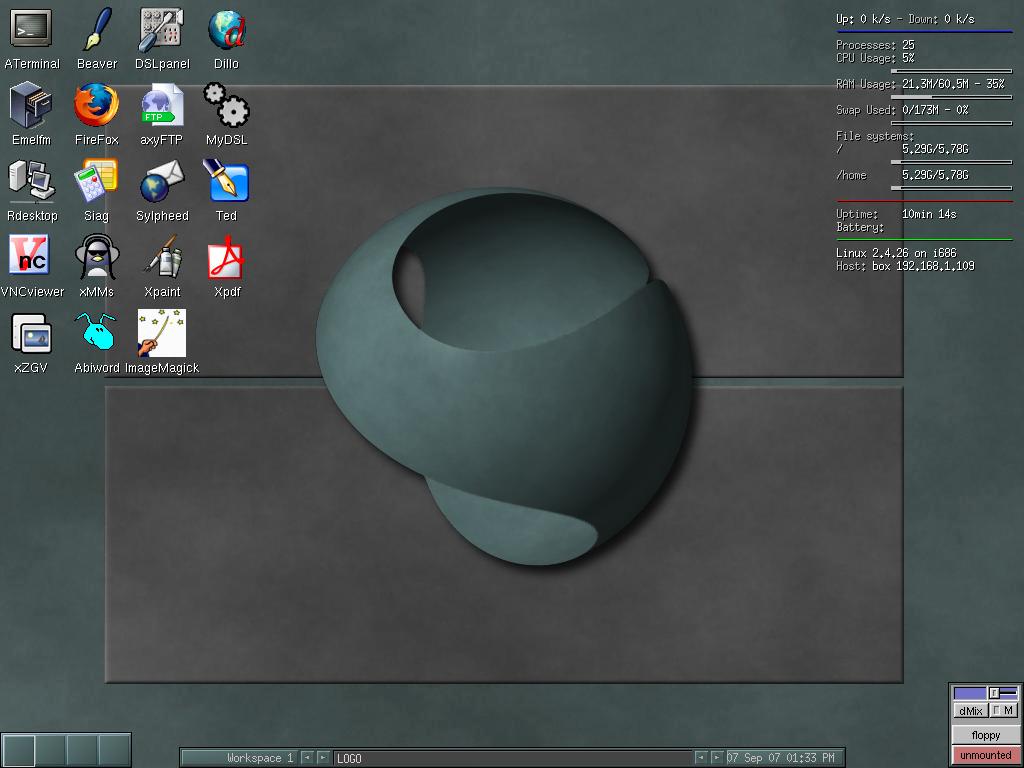So far, I've set up 4 different Ubuntu 7.10 Gutsy Gibbon installations. Here's my thoughts;
Desktop SetupTo save the servers, I used BitTorrent to download the Gutsy Desktop LiveCD. It actually came in really fast. I burned the disk, then tested it on a FreekBox Installation.
- 1.6 GHz AMD Athlon XP
- 384 mb ram - I'd like to have much more
- 20 GB 7200 rpm hard drive
- 32 mb Graphics Card
This was a good system to test. To my surprise, the Desktop version now includes an OEM (original equipment manufacturer) installation option, so I went that route. The disk booted to the desktop, and I thought, "I guess that part isn't working yet." But, when I clicked on the Install icon, within a few clicks I saw that I was indeed creating an OEM installation. I was really glad to see this. Now, setting up a new FreekBox for Free Geek is a little easier. It's much more graphical from the Desktop CD.
The installation when fine. But, it didn't recognize the Wireless Network Adapter I'd installed. Well, it recognized it, but it wasn't working. I plugged in the wired adapter, did the updates and added a few programs, and when I restarted, the system asked if I wanted to download the 'restricted drivers' to enable the wireless adapter. Duh! Within a few seconds it was working.
From this initial test, I was really happy with Gutsy. A few new tools I've yet to try out, but I'll report on those later.
My Laptop- 2.8 GHz
- 964 mb ram
- 60 GB hd 4800 rpm
- 64 mb shared graphics memory
I was a bit apprehensive about installing Gutsy on my laptop, as it's my primary computer. I'd tested IE for Linux on the above system, and it worked fine, so I took the plunge.
First, I tried the "Upgrade Now" prompt from the Upgrade Manager. That didn't go too well, but I expected such. I'd made too many specific changes, and added too many independent repository sources.
Next, I followed the same installation method as the above Desktop, with disastrous results. The installation took almost 2 hours -not a good sign at all. When I finally booted up; the boot screen never showed, the graphics driver wasn't the right one, no sound, and the computer wouldn't shut down. Not Acceptable!
I downloaded, burned, and installed Gutsy again (after a good Dban on the machine) with an Alternate Install CD. This time - Gutsy Excellence! The installation was actually faster than before - less than 10 minutes to desktop.
I've yet to try out battery life, but I'm expecting that I'll still have to make the power adjustments on it. Bonus if I don't have to fiddle with that. The computer does seem much quieter than before. The fan only comes on occasionally now. Another bonus.
Xubuntu Installation- 600 MHz Celeron
- 256 mb ram
- 15 gb hd - probably 4800 or less rpm
- no clue on graphics
I used the Alternate Install CD. On old equipment, I don't bother with the LiveCD. Once again, everything worked perfectly. This version of Xubuntu actually looks more professional -less like a comic book. Not that I minded the comic book look before.
EvaluationWhile the Live CD is good for trying out Ubuntu, I still highly recommend using the Alternate Install CD if you know for sure you want to use Ubuntu, either as the sole OS, or for dual boot. Maybe the LiveCD problems only applied to my specific laptop. Maybe not. Either way, I still recommend the Alternate Install CD. It way faster to install it that way, too.
From the end user perspective, Gutsy is simply an upgrade of some desktop things, and program updates. If I was an end user, I'd be a little upset. Couldn't these things simply be upgraded by the Update Manager, like they do throughout the life-cycle? Why should I risk a broken upgrade -like on my laptop- for newer programs?
Now, to answer my own questions, I know that each Ubuntu version is an entire newly created distribution, and not just an 'upgrade'. Things that are needed are added, and things that aren't needed are dropped. The latest kernel, the newest Gnome (or KDE, or XFCE), the newest file manager, and finally, the newest programs. And, of course, new artwork. For an average geek, the newest version is a must. The the average user, it's not. The average user will be just fine with Ubuntu 6.06 Dapper Drake. After all, it's only a 1 year, 4 months older! Then again, things progress way fast in the Open Source world.
My conclusion: Use the Alternate Install CD.






